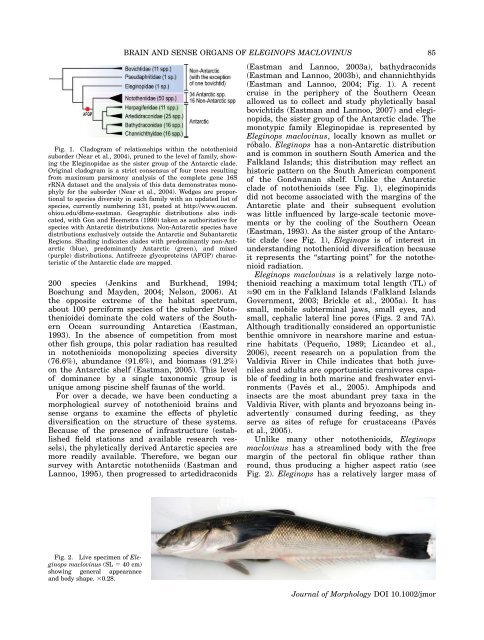Brain and Sense Organ Anatomy and Histology of the ... - Lannoo Lab
Brain and Sense Organ Anatomy and Histology of the ... - Lannoo Lab
Brain and Sense Organ Anatomy and Histology of the ... - Lannoo Lab
You also want an ePaper? Increase the reach of your titles
YUMPU automatically turns print PDFs into web optimized ePapers that Google loves.
BRAIN AND SENSE ORGANS OF ELEGINOPS MACLOVINUS 85<br />
Fig. 1. Cladogram <strong>of</strong> relationships within <strong>the</strong> noto<strong>the</strong>nioid<br />
suborder (Near et al., 2004), pruned to <strong>the</strong> level <strong>of</strong> family, showing<br />
<strong>the</strong> Eleginopidae as <strong>the</strong> sister group <strong>of</strong> <strong>the</strong> Antarctic clade.<br />
Original cladogram is a strict consensus <strong>of</strong> four trees resulting<br />
from maximum parsimony analysis <strong>of</strong> <strong>the</strong> complete gene 16S<br />
rRNA dataset <strong>and</strong> <strong>the</strong> analysis <strong>of</strong> this data demonstrates monophyly<br />
for <strong>the</strong> suborder (Near et al., 2004). Wedges are proportional<br />
to species diversity in each family with an updated list <strong>of</strong><br />
species, currently numbering 131, posted at http://www.oucom.<br />
ohiou.edu/dbms-eastman. Geographic distributions also indicated,<br />
with Gon <strong>and</strong> Heemstra (1990) taken as authoritative for<br />
species with Antarctic distributions. Non-Antarctic species have<br />
distributions exclusively outside <strong>the</strong> Antarctic <strong>and</strong> Subantarctic<br />
Regions. Shading indicates clades with predominantly non-Antarctic<br />
(blue), predominantly Antarctic (green), <strong>and</strong> mixed<br />
(purple) distributions. Antifreeze glycoproteins (AFGP) characteristic<br />
<strong>of</strong> <strong>the</strong> Antarctic clade are mapped.<br />
200 species (Jenkins <strong>and</strong> Burkhead, 1994;<br />
Boschung <strong>and</strong> Mayden, 2004; Nelson, 2006). At<br />
<strong>the</strong> opposite extreme <strong>of</strong> <strong>the</strong> habitat spectrum,<br />
about 100 perciform species <strong>of</strong> <strong>the</strong> suborder Noto<strong>the</strong>nioidei<br />
dominate <strong>the</strong> cold waters <strong>of</strong> <strong>the</strong> Sou<strong>the</strong>rn<br />
Ocean surrounding Antarctica (Eastman,<br />
1993). In <strong>the</strong> absence <strong>of</strong> competition from most<br />
o<strong>the</strong>r fish groups, this polar radiation has resulted<br />
in noto<strong>the</strong>nioids monopolizing species diversity<br />
(76.6%), abundance (91.6%), <strong>and</strong> biomass (91.2%)<br />
on <strong>the</strong> Antarctic shelf (Eastman, 2005). This level<br />
<strong>of</strong> dominance by a single taxonomic group is<br />
unique among piscine shelf faunas <strong>of</strong> <strong>the</strong> world.<br />
For over a decade, we have been conducting a<br />
morphological survey <strong>of</strong> noto<strong>the</strong>nioid brains <strong>and</strong><br />
sense organs to examine <strong>the</strong> effects <strong>of</strong> phyletic<br />
diversification on <strong>the</strong> structure <strong>of</strong> <strong>the</strong>se systems.<br />
Because <strong>of</strong> <strong>the</strong> presence <strong>of</strong> infrastructure (established<br />
field stations <strong>and</strong> available research vessels),<br />
<strong>the</strong> phyletically derived Antarctic species are<br />
more readily available. Therefore, we began our<br />
survey with Antarctic noto<strong>the</strong>niids (Eastman <strong>and</strong><br />
<strong>Lannoo</strong>, 1995), <strong>the</strong>n progressed to artedidraconids<br />
(Eastman <strong>and</strong> <strong>Lannoo</strong>, 2003a), bathydraconids<br />
(Eastman <strong>and</strong> <strong>Lannoo</strong>, 2003b), <strong>and</strong> channichthyids<br />
(Eastman <strong>and</strong> <strong>Lannoo</strong>, 2004; Fig. 1). A recent<br />
cruise in <strong>the</strong> periphery <strong>of</strong> <strong>the</strong> Sou<strong>the</strong>rn Ocean<br />
allowed us to collect <strong>and</strong> study phyletically basal<br />
bovichtids (Eastman <strong>and</strong> <strong>Lannoo</strong>, 2007) <strong>and</strong> eleginopids,<br />
<strong>the</strong> sister group <strong>of</strong> <strong>the</strong> Antarctic clade. The<br />
monotypic family Eleginopidae is represented by<br />
Eleginops maclovinus, locally known as mullet or<br />
róbalo. Eleginops has a non-Antarctic distribution<br />
<strong>and</strong> is common in sou<strong>the</strong>rn South America <strong>and</strong> <strong>the</strong><br />
Falkl<strong>and</strong> Isl<strong>and</strong>s; this distribution may reflect an<br />
historic pattern on <strong>the</strong> South American component<br />
<strong>of</strong> <strong>the</strong> Gondwanan shelf. Unlike <strong>the</strong> Antarctic<br />
clade <strong>of</strong> noto<strong>the</strong>nioids (see Fig. 1), eleginopinids<br />
did not become associated with <strong>the</strong> margins <strong>of</strong> <strong>the</strong><br />
Antarctic plate <strong>and</strong> <strong>the</strong>ir subsequent evolution<br />
was little influenced by large-scale tectonic movements<br />
or by <strong>the</strong> cooling <strong>of</strong> <strong>the</strong> Sou<strong>the</strong>rn Ocean<br />
(Eastman, 1993). As <strong>the</strong> sister group <strong>of</strong> <strong>the</strong> Antarctic<br />
clade (see Fig. 1), Eleginops is <strong>of</strong> interest in<br />
underst<strong>and</strong>ing noto<strong>the</strong>nioid diversification because<br />
it represents <strong>the</strong> ‘‘starting point’’ for <strong>the</strong> noto<strong>the</strong>nioid<br />
radiation.<br />
Eleginops maclovinus is a relatively large noto<strong>the</strong>nioid<br />
reaching a maximum total length (TL) <strong>of</strong><br />
90 cm in <strong>the</strong> Falkl<strong>and</strong> Isl<strong>and</strong>s (Falkl<strong>and</strong> Isl<strong>and</strong>s<br />
Government, 2003; Brickle et al., 2005a). It has<br />
small, mobile subterminal jaws, small eyes, <strong>and</strong><br />
small, cephalic lateral line pores (Figs. 2 <strong>and</strong> 7A).<br />
Although traditionally considered an opportunistic<br />
benthic omnivore in nearshore marine <strong>and</strong> estuarine<br />
habitats (Pequeño, 1989; Lic<strong>and</strong>eo et al.,<br />
2006), recent research on a population from <strong>the</strong><br />
Valdivia River in Chile indicates that both juveniles<br />
<strong>and</strong> adults are opportunistic carnivores capable<br />
<strong>of</strong> feeding in both marine <strong>and</strong> freshwater environments<br />
(Pavés et al., 2005). Amphipods <strong>and</strong><br />
insects are <strong>the</strong> most abundant prey taxa in <strong>the</strong><br />
Valdivia River, with plants <strong>and</strong> bryozoans being inadvertently<br />
consumed during feeding, as <strong>the</strong>y<br />
serve as sites <strong>of</strong> refuge for crustaceans (Pavés<br />
et al., 2005).<br />
Unlike many o<strong>the</strong>r noto<strong>the</strong>nioids, Eleginops<br />
maclovinus has a streamlined body with <strong>the</strong> free<br />
margin <strong>of</strong> <strong>the</strong> pectoral fin oblique ra<strong>the</strong>r than<br />
round, thus producing a higher aspect ratio (see<br />
Fig. 2). Eleginops has a relatively larger mass <strong>of</strong><br />
Fig. 2. Live specimen <strong>of</strong> Eleginops<br />
maclovinus (SL 5 40 cm)<br />
showing general appearance<br />
<strong>and</strong> body shape. 30.28.<br />
Journal <strong>of</strong> Morphology DOI 10.1002/jmor

















